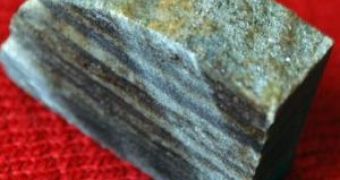Carbon dioxide may currently be blamed for the global warming, but in the past, it acted as a 'thermostat' that saved the Earth from being completely frozen like Mars and the more remote planets of the Sun System.
This was proven by the analysis of the world's oldest sedimentary rocks. The ancient rocks (photo, a piece of those rocks), found in 2001 on the eastern shore of Hudson Bay in northern Quebec, Canada, were investigated by a team at the University of Chicago and the University of Colorado. "Our study shows the greenhouse gas that could have sustained surface temperatures above freezing 3.75 billion years ago may have been carbon dioxide," said Nicolas Dauphas, Assistant Professor in Geophysical Sciences at the University of Chicago.
Astrophysicists believe that during that time the sun was 25 % fainter than today, but previous researches revealed that liquid water existed at the Earth's surface even though the weak sun could have been able to warm the Earth above freezing conditions by itself, thus only greenhouse gases like carbon dioxide or methane could have risen the planet's temperature.
During Earth's 4.5-billion-year history, geologic processes destroyed and recycled its crust on vast time scales, thus only scraps of land containing remains of the planet's oldest rock were left.
The oldest rocks found till now are these from Quebec and one outcropping in western Greenland. "Scientists have studied those rocks exhaustively for more than three decades. But the limited extent of the rocks of this antiquity may have provided only a biased view of the early Earth. A critical issue with these rocks is that they have been cooked and deformed during burial in the crust for several hundred million years, which makes it difficult to identify their nature," Dauphas said.
"(The 3.75 billion years old world) ... would have appeared to be a totally alien world to us, with a dense atmosphere of carbon dioxide and methane that would have imparted a reddish cast to the sky, and deep dark greenish-blue oceans of iron-rich water washing onto beaches of small continents scattered across the globe," said Stephen Mojzsis of the University of Colorado.
The team focused on the analysis of the isotopic composition of the iron in the old rocks. "Sediments that formed by precipitation from seawater have a very distinct signature of iron isotopes. We found that indeed they had the typical signature of something that formed by precipitation in a marine setting." explained Dauphas.
The iron must have been expelled with other metals through hydrothermal vents placed along mid-ocean ridges, where molten lava goes out on the sea floor to make new oceanic crust.
In current oxygen-rich oceans, the iron rapidly precipitates and stores near these vents but in the primordial oxygen-free oceans, 3.8 billion years ago, oceanic flows could carry the iron long distances before being partially oxidized and sedimented on the sea-floor, surviving till now as banded iron formations. "There are no banded iron formations being produced at present because there is too much oxygen," Dauphas said.
The Greenland rocks had already pointed to the existence of ocean water during Precambrian Period, the early Earth's age. The Quebec rocks revealed more: the Precambrian oceans were also rich in iron carbonates. "Iron carbonates can only form in an atmosphere that contains far higher levels of carbon dioxide than are found in Earth's atmosphere today," Dauphas said.
"If it gets cold, ice caps form, chemical weathering decreases, carbon dioxide accumulates in the atmosphere, which increases the greenhouse effect and surface temperatures. If it gets hot, the rate of chemical weathering increases, the rate of burial of sedimentary carbonates increases, the amount of carbon dioxide in the atmosphere and surface temperatures decrease," Dauphas said. "Still, it is possible that such a thermostat was at work as early as 3.75 billion years ago," he said. This supported early life on Earth.
Photo credit: Dan Dry

 14 DAY TRIAL //
14 DAY TRIAL //